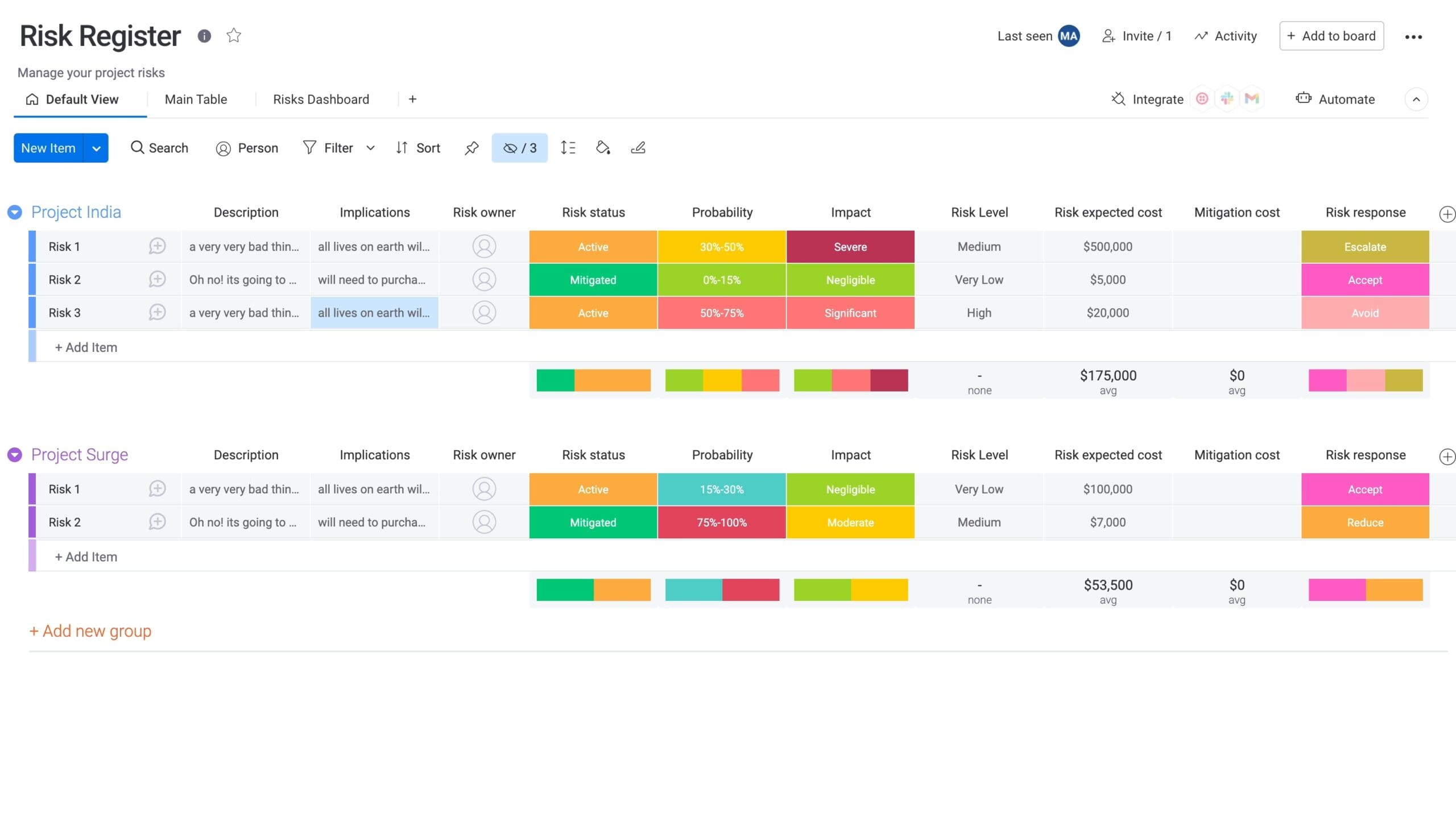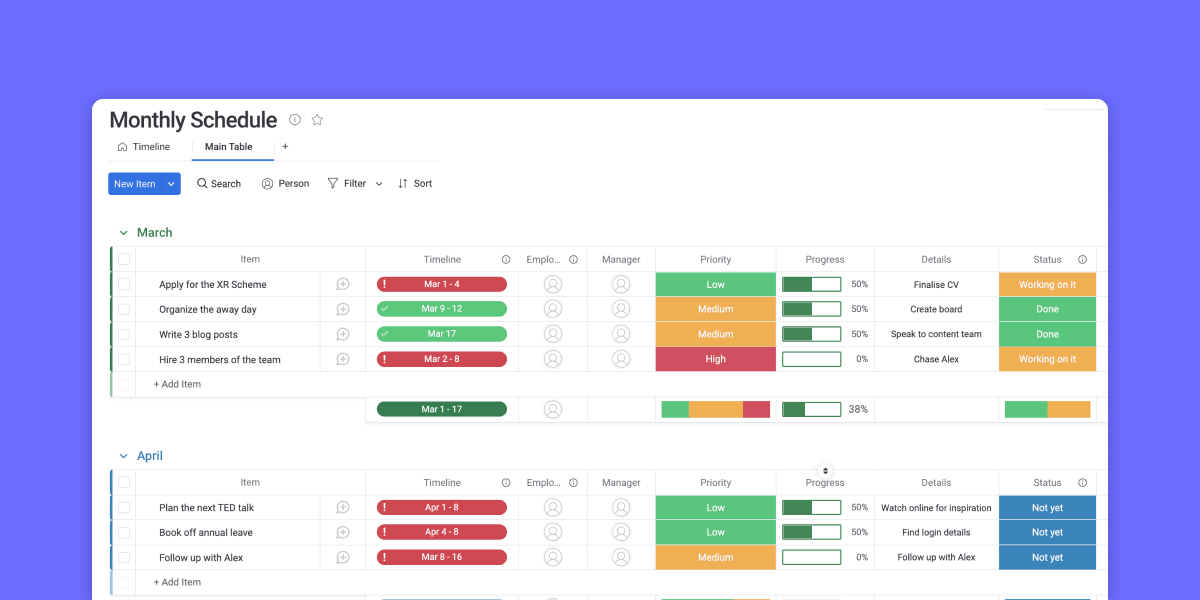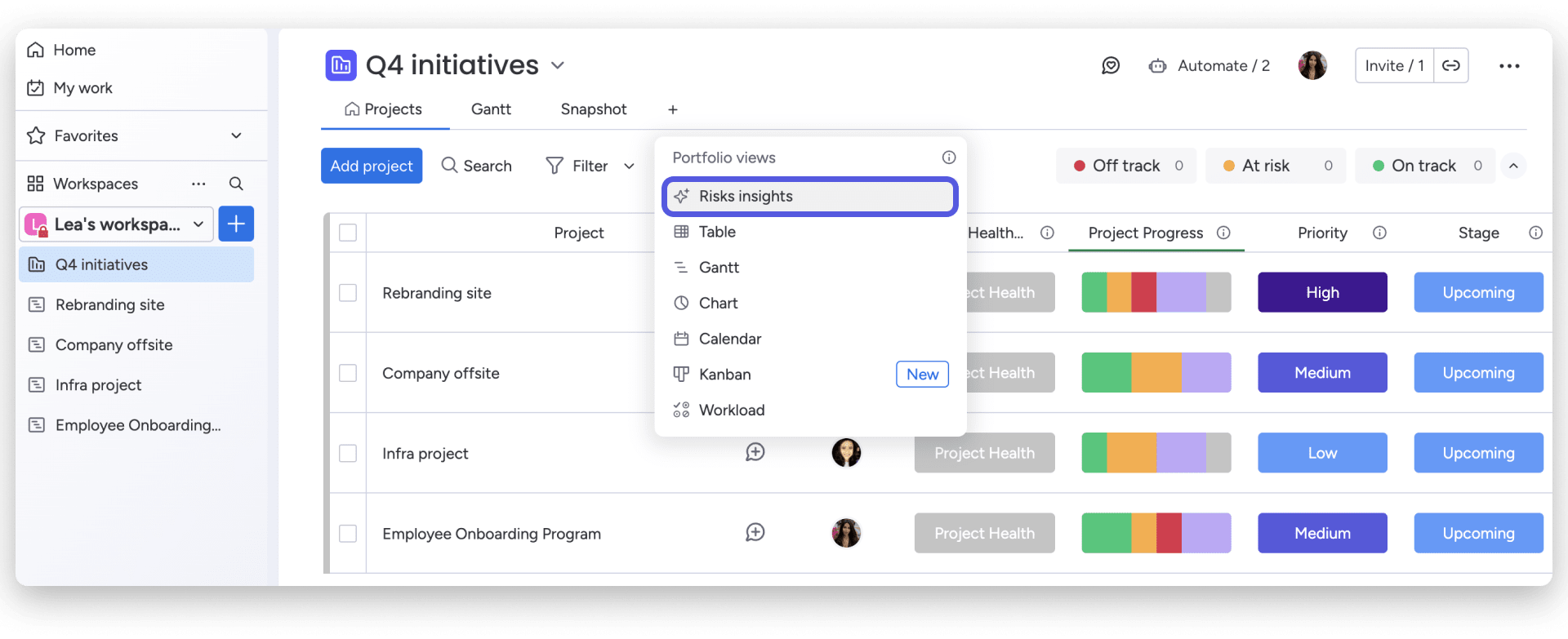No project goes exactly as planned. Timelines shift, priorities change, and unforeseen challenges appear when least expected. The difference between a setback and a full-scale disruption often comes down to preparation — having a clear process in place before the pressure hits.
That’s where a project risk assessment template becomes essential. It turns uncertainty into structure by helping teams identify potential threats early, evaluate their impact, and outline practical response strategies. Instead of reacting when things go wrong, teams stay ahead of problems with data-backed insights and clear accountability.
The following sections explore proven templates and approaches that make risk management repeatable, measurable, and effective – so every project runs with fewer surprises and greater control.
Key takeaways
- Begin with thorough risk identification: review all major categories — from budget and scheduling to compliance and technical issues — to spot potential threats early.
- Prioritize visually with impact matrices: use probability–impact grids to focus on the risks most likely to affect project outcomes.
- Enhance visibility through monday work management: automate tracking, apply AI-driven risk detection, and use real-time dashboards to keep teams aligned and informed.
- Keep assessments current: revisit and update risk data regularly, especially at key milestones or when project scope changes.
- Engage stakeholders early: include key decision-makers in risk identification to capture diverse perspectives and secure buy-in for mitigation plans.
What is a project risk assessment template?
A project risk assessment template is a structured framework used to identify, evaluate, and manage potential threats before they affect project outcomes. It serves as an early warning system that helps teams act before issues escalate — a crucial advantage when research shows a mere 0.5% of projects achieve all their promised benefits.<!–EndFragment–>
These templates transform chaotic “what-ifs” into organized action plans. Instead of scrambling when issues arise, you’ll have documented risks, assigned risk owners, and response strategies ready to deploy.
Key components every template should include
Every effective risk assessment template needs specific elements to capture the full picture of project threats.
These components work together to create a comprehensive view that supports smart decision-making:
- Risk description: provide a concise explanation of what could go wrong and how it might affect the project.
- Probability rating: indicate how likely the risk is to occur, using a consistent scale across all identified risks.
- Impact assessment: describe the potential consequences for timeline, budget, quality, or team performance if the risk materializes.
- Risk score: combine probability and impact ratings to prioritize which risks require immediate attention.
- Response strategy: outline the actions planned to prevent, reduce, or manage each identified risk.
- Risk owner: assign responsibility for monitoring and managing the specific risk throughout the project.
- Status tracking: record the current state of the risk along with any ongoing mitigation efforts.
Difference between risk assessment and risk management templates
templates focus on identifying and evaluating potential threats before they affect a project. Risk management templates, on the other hand, extend that process by tracking mitigation actions, monitoring changes, and capturing lessons learned along the way.
Assessment templates are most useful during planning and at key milestones, while management templates remain active throughout the project lifecycle, adapting as risks evolve and new ones emerge.
5 essential project risk assessment templates
Having the right templates saves you from starting from scratch with every project. These five proven formats cover the entire risk management lifecycle: from initial identification to executive reporting.
Risk identification checklist template
Start here when you’re working on a new project type or need to ensure comprehensive coverage. This template provides categories and prompts that help teams think beyond obvious risks.
The checklist breaks risks into categories like technical, financial, resource, and external factors. Within each category, you’ll find common examples that spark discussion about project-specific threats.
Probability and impact matrix template
Move beyond simple lists with this visual prioritization tool. A probability and impact matrix helps you plot each risk based on its likelihood and potential severity, which is a proven method for prioritizing identified risks and focusing your team’s attention.
The standard 5×5 grid creates clear zones — from low-probability, low-impact risks you can monitor casually to high-probability, high-impact threats that need immediate action plans.
Risk register and tracking template
Your comprehensive command centre for ongoing project risk management. This template captures detailed information about each risk and tracks how it evolves throughout your project.
Standard fields include risk ID, category, description, probability, impact, calculated score, mitigation actions, deadlines, and current status. With modern platforms like monday work management, these risk registers update in real time as team members log progress.
Risk mitigation planning template
Focus specifically on developing response strategies with this action-oriented template. For each identified risk, you’ll choose from four standard responses:
- Avoid: change your approach to eliminate the risk entirely.
- Mitigate: take steps to reduce probability or impact.
- Transfer: shift the risk to another party through insurance or contracts.
- Accept: acknowledge the risk and prepare contingency plans.
Executive risk dashboard template
Translate detailed risk data into strategic insights for leadership. This template highlights top risks, trend indicators, and mitigation progress, providing executives with concise, strategic insights.
Visual elements like heat maps and status indicators make it easy for stakeholders to grasp risk levels and make informed decisions quickly.
Try monday work management
How to complete your risk assessment template
Turning a blank template into a powerful risk management tool requires a methodical approach.
Follow these five practical steps to build a comprehensive risk assessment that keeps your projects on track even when challenges arise.
Step 1: identify potential project risks
Cast a wide net during risk identification. Bring together team members from different functions — they’ll spot risks others might miss. Completing a risk analysis can also help confirm your team’s perspective on potential threats.
Start with these proven techniques:
- Review similar past projects for recurring issues.
- Question every assumption about resources, timelines, and dependencies.
- Map out all external dependencies that could cause delays.
- Consider market conditions and organizational changes.
Document everything, even risks that seem unlikely (you can prioritize later, but you can’t manage risks you haven’t identified).
Step 2: evaluate risk probability
Assign likelihood ratings to each identified risk. Keep it simple with Low/Medium/High ratings, or use percentage ranges if your organization prefers precision.
Base your estimates on historical data when available. For new types of risks, consult subject matter experts and document the reasoning behind your probability assessments.
Step 3: assess risk impact
Look beyond immediate effects when evaluating impact. A supplier delay might directly impact your timeline but could also affect team morale, stakeholder confidence, and future project funding.
An impact analysis can further help quantify these potential ripple effects for more informed decision-making.
Rate impacts consistently across all risks. Whether you use numeric scales or descriptive categories, ensure everyone understands what “high impact” actually means for your project.
Step 4: calculate risk priority scores
Combine probability and impact to create priority rankings. The simplest approach multiplies these two factors, but you can add weighting for strategic importance or other factors.
These scores guide resource allocation — you’ll develop a risk management plan for high-priority risks while simply monitoring lower-scored threats.
Step 5: plan risk response strategies
Turn assessment into action by defining specific responses for each significant risk. Assign clear owners, set deadlines for preventive actions, and establish triggers that activate contingency plans.
Document these responses in your risk register so everyone knows their role when risks materialize.
9 critical risk categories for your assessment
Comprehensive risk assessment examines threats from multiple angles. Review each category systematically to ensure nothing slips through the cracks.
You can also use a risk breakdown structure to organize threats into hierarchical levels.
Budget and cost overrun risks
Financial risks can cascade quickly through your project. Watch for vendor price increases, currency fluctuations, resource scarcity driving up costs, and scope creep that wasn’t budgeted.
Build contingency funds into your budget and establish clear change control processes to manage financial risks proactively.
Schedule and timeline risks
Delays compound as projects progress. Common culprits include resource conflicts, approval bottlenecks, technical challenges, and dependencies on external parties.
Create realistic timelines with built-in buffers. When you identify schedule risks, develop specific acceleration plans you can activate if needed.
Resource and capacity risks
People and equipment constraints often become project bottlenecks. Key concerns include staff turnover, skill gaps, equipment failures, and competing projects drawing away resources.
Map critical resources early and identify backup options. Cross-training team members provides flexibility when unexpected gaps appear.
Quality and performance risks
Poor-quality deliverables can harm credibility, increase costs, and delay completion. These risks often arise from:
- Unclear requirements: teams lack alignment on scope or expectations.
- Inadequate testing: issues go unnoticed until late in the project.
- Rushed timelines: corners get cut to meet deadlines.
- Integration challenges: new components fail to work smoothly with existing systems.
Set clear quality standards at the start and include regular review checkpoints in your project plan. Preventing issues early is always more efficient than fixing them later.
Stakeholder and communication risks
Misaligned expectations can easily derail projects. This risk is underscored by research showing a major perception gap: while 45% of senior leaders believe change is managed ’very well,’ only 23% of individual contributors agree. Watch for absent stakeholders, conflicting priorities between groups, communication gaps, and shifting requirements mid-project.
Create stakeholder maps, establish regular communication rhythms, and document all requirement changes to manage these risks.
Technical and technology risks
New technologies bring uncertainty. Consider whether unproven solutions will perform as promised, systems will integrate smoothly, and your team has necessary technical skills.
Prototype early, plan for integration testing, and have technical experts review your approach before committing fully.
Compliance and regulatory risks
Regulatory violations bring serious consequences. Stay alert to changing regulations, audit requirements, data privacy rules, and industry standards that affect your project.
Involve compliance experts early in planning. Build their requirements into your project design rather than retrofitting later.
Market and external risks
Outside forces can disrupt your project. Monitor economic conditions, competitor moves, supplier stability, and political or regulatory changes that might impact your work.
While you can’t control these factors, you can prepare contingency plans and monitor early warning indicators.
Operational process risks
Internal processes create their own risks. Common issues include poor change management, weak governance structures, knowledge gaps, and organizational restructuring.
Document processes clearly and ensure knowledge transfer happens continuously, not just at project end.
Try monday work management
How to build an effective risk matrix
Risk matrices translate complex assessments into clear, visual insights that make prioritization straightforward. By mapping likelihood and impact, teams can quickly see which risks need action and which simply require monitoring.
The steps below explain how to set probability scales, define impact levels, and create heat maps that make risk management easier and more effective.
Setting probability scales
Choose probability scales that work for your team’s decision-making style. Options include:
| Scale type | Levels | Definition |
|---|---|---|
| Simple | Low/Medium/High | Easy to apply consistently |
| Percentage | 20% increments | More precise for calculation |
| Descriptive | Rare/Possible/Likely | Intuitive for non-technical teams |
Defining impact severity levels
Impact scales should reflect what matters most to your project. Consider effects on schedule, budget, quality, and strategic objectives.
Use specific thresholds rather than vague descriptions. Define what constitutes a “major” schedule impact — is it two weeks or two months?
Creating risk heat maps
Color-coded heat maps make risk levels immediately visible. Plot risks on your probability-impact grid and use colors to show priority zones.
With intuitive work management platforms like monday work management, these heat maps update automatically as risk assessments change, keeping everyone aligned on current priorities.
Risk assessment best practices
Effective risk assessment isn’t just about having templates — it’s about implementing them strategically. These proven practices help transform risk documentation from a checkbox exercise into a powerful project protection mechanism:
- Involve key stakeholders early: stakeholders bring unique perspectives on risks and impacts. Include them in initial risk identification sessions and regular reviews.
- Update assessments regularly: risks evolve as projects progress. Schedule regular reviews at milestones, monthly for active risks, and whenever significant changes occur.
- Document everything: capture not just risks but also your reasoning, assumptions, and decisions. This documentation supports knowledge transfer and helps future projects learn from your experience. Use consistent formats and centralized storage so information remains accessible to those who need it.
- Connect risks to project goals: link each risk to specific project objectives. This connection helps prioritize responses and communicate why certain risks matter more than others. When stakeholders understand how risks threaten project success, they’re more likely to support risk mitigation efforts.

Transform risk assessment with monday work management
Effective risk management goes beyond static templates. As projects evolve, risks shift — and tracking those changes requires a system that adapts in real time. With capabilities for automation, visibility, and AI-driven insights, monday work management helps teams move from reactive problem-solving to proactive risk control.
The features below show how to turn risk assessment into a living, collaborative process that keeps every stakeholder informed and aligned.
Automated risk tracking
Set up automated notifications when risk scores exceed thresholds or deadlines approach. AI-powered features can even suggest risk categories based on project descriptions and flag potential issues in status updates.
Your team stays informed without manual status chasing, freeing time for actual risk management rather than administrative tasks.
Real-time risk dashboards
Transform spreadsheets into visual dashboards that update automatically. See top risks, mitigation progress, and trend indicators at a glance.
Different views serve different audiences — detailed registers for project managers, summary heat maps for executives, and action lists for risk owners.
AI-powered risk detection
AI can uncover risks that traditional monitoring might overlook. By analyzing key project data, it highlights potential issues before they escalate.
- Pattern recognition: detect risks by comparing current project activity to historical performance and outcomes.
- Resource and timeline analysis: identify workload imbalances or scheduling pressures that signal potential delays.
- Early alerts: flag warning signs similar to past project failures, prompting teams to take action before problems grow.
Cross-portfolio risk visibility
See risk patterns across multiple projects. Identify systemic issues like resource conflicts or common technical challenges that individual project views might miss.
This portfolio perspective helps leadership make strategic decisions about risk tolerance and resource allocation.
Ready to move beyond static templates? Get Started with monday work management and build a living risk management system that evolves with your projects.
Try monday work managementFrequently asked questions
How often should I update my project risk assessment template during an active project?
For an active project, you should update your risk assessment template monthly and at every major milestone. Additionally, review and update whenever significant changes occur, such as scope adjustments, team changes, or external factors that could impact your project.
What's the difference between qualitative and quantitative risk assessment in templates?
Qualitative assessment uses descriptive scales like Low/Medium/High to evaluate risks based on judgment and experience. Quantitative assessment assigns numerical values and uses calculations to determine risk levels, often involving financial impact estimates or statistical probability.
Should I use the same risk assessment template for agile and waterfall projects?
While the basic template structure can work for both, customize the approach for each methodology. Agile projects benefit from lightweight templates updated each sprint, while waterfall projects typically use more detailed templates with longer-term risk horizons.
How do I determine the right risk tolerance level for my project?
Risk tolerance depends on your project’s strategic importance, available resources, and stakeholder expectations. Discuss acceptable risk levels with project sponsors and document agreed thresholds for different risk categories in your template.
What's the best way to get team members to actively participate in risk assessment?
Make risk assessment relevant by showing how past risk planning prevented project failures. Keep sessions focused and time-boxed, and demonstrate how identifying risks early makes everyone’s job easier during execution.
How can I track risk mitigation actions effectively in my template?
Include specific fields for mitigation actions, responsible owners, target dates, and status updates in your risk register. Use automated reminders and progress tracking to ensure actions move forward without constant manual follow-up.
 Get started
Get started 

